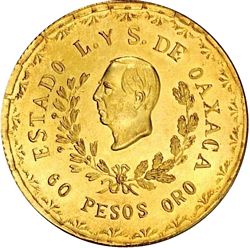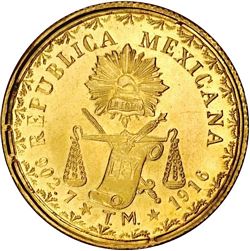60 pesos gold


KM-755, GB-379, A-OX-178 $60 gold (Stack’s-Bowers, The Louis E. Eliasberg, Sr. Collection, 15 April 2005, lot 3424)
In his memoirs Pablo Neuman recordedBoletín Numismatico,
To fulfil my promise to the Governor, I arrived in Oaxaca the following Saturday and on Sunday sent to let him know I was at his disposition. An appointment was fixed for Monday at nine o'clock when I was received and when I gave him examples of my tokens. The Governor was interested in the manufacture of the pieces and finally told me that "if we have machinery the State Government could provide enough coin for your needs".
"Sir, the only thing that you need is the metal, as the machinery is some where in the city and has been since the end of the last century”
"I would like to see this machinery."
"If you wish Governor. I'll take you right now.”
We then went to a colonial style house in front of the Cathedral where in 1910 were the Stamp offices, the mining agency, and the Federal Offices. In that year the State Government had charged me to find machinery for a Mint. Everything was very broken down but it could be made to work.
The Governor wanted me to take charge of the Mint, but I could not because of my job in San Miguel Peras. I offered to help and to cooperate to the best of my ability and I recommended the following people who were able to undertake the work - Simon Ferguson, John de Coe, José Massa. Paul Ehrlich and August Hamenstein of whom the first three took a most active part in the setting up and later in the actual coinage.
Mr. John De Coe busied himself in engraving the first dies. He used for the reverse of some of the coins, particularly those of "Dos Pesos" some dies which had been used for the coinage of the last century. Mr. Teofilo Monroy was made Director of the resurrected Mint, and a Mr. Bellon who with his brothers had a commercial establishment - "Bellon Hnos." - also took part. They sold old gold pieces for conversion to the new issue.
I only sold gold dust from the mountains of the State, and that too in small quantities for very seldom was more than a kilogramme sent. For the striking of the famous 60 peso pieces I handed over an ingot of no more than 1,200 grammes to Governor Davila of about .859 fineness. The usual natural fineness in San Miguel Peras was about 820 and only on two occasions Wenceslao Garcia had the luck by means of a mercury amalgam to get 960 and 940.
Opinions vary about the number of 60 peso pieces actually coined. It is, however, quite certain that the number is very limited in that the amount of gold I sold was very small and that striking only started on the eve of the collapse of the government of the Sovereign State whose flight was a hurried one. Defective pieces began to come out and I have only seen seven examples of which two were given to the Governor, two to the Military Commander in Chief Guillermo Meixueiro, one to the Bustamante family. one to a teacher of English Mr. Eusebio P. León, and the other to Mr. Manuel García Vigil who was a nephew of Wenceslao Garcia, and who later became Governor of Oaxaca. Even though one triplicates or even quintuplicates the number seven it is easy to see that the gold 60 peso piece is evidently much rare than is generally believed.”
Teofilo Monroy’s son, Miguel, adds
"The dies for the sixty peso gold Oaxaca coin were personally cut by Mr. Teófilo Monroy, on the night preceding the evacuation of the city of Oaxaca by the troops of the Sovereign Government of that State. He only struck forty or forty-five coins. All the specimens were confiscated by members of the Carrancista army, who on showing them: off were heard saying that they were only gilt coins whose circulation the Sovereign Government wanted to force with a nominal value of sixty pesos”.
''Ingeniero Howard L. Elton technically helped in the design of all the Oaxaca coins and very particularly in the arrangement of the sixty peso pieces. This gentleman was executed by the Carranza troops. On the other band, Ingeniero Pablo Neumann was the one who sold the gold required for the sixty peso specimens. By the way it is interesting to note that all efforts were made to design this piece with the same diameter and thickness of the old "pesos fuertes" (large dollars) and that the fineness of the metal used was the same shown on those old pesos, that is 902.7".
[ ] argues that four main types of the 60 Pesos can exist.
l. Original strikings.
2. Restrikes from the original dies, which were in the possession of Miguel Monroy in 1932J. Sanchez Garza, and acquired by the ANS in 1951.
3. Cast copies of the original coin or restrike. These are lacking in three respects: (1) they have a granulated surface; (2) there is an absence of any true stress marks; and (3) the faulty duplication of the milled or reeded edge, which is is all perfect and at right angles to the planchet. and
4. Counterfeits made from newly prepared dies. The lettering differs from the original in shape and size. Also in depth of cutting. The ornaments around the edge does not follow the original design. The period after the T in T.M. is too far from the T.
FloresC. "Woody" Woodworth and Joe Flores, La Ventana, privately printed, 1988 states that the obverse die has several identifying marks. The top left of the "E" in DE and the bottom of the "C" in OAXACA are re-engraved and most collectors also look for three small vertical scratches on Juárez' face in the area of the cheek-bone. The reverse shows the "P" and "U" of REPUBLICA and the "9" of 902.7 re-engraved.
